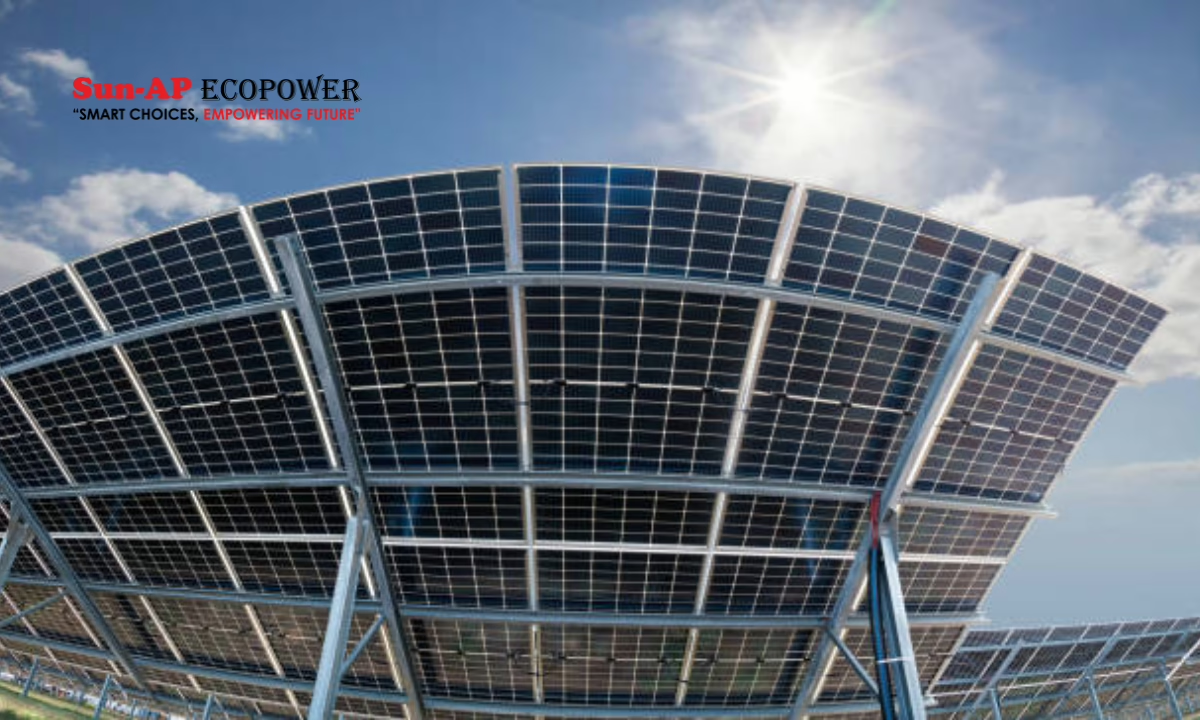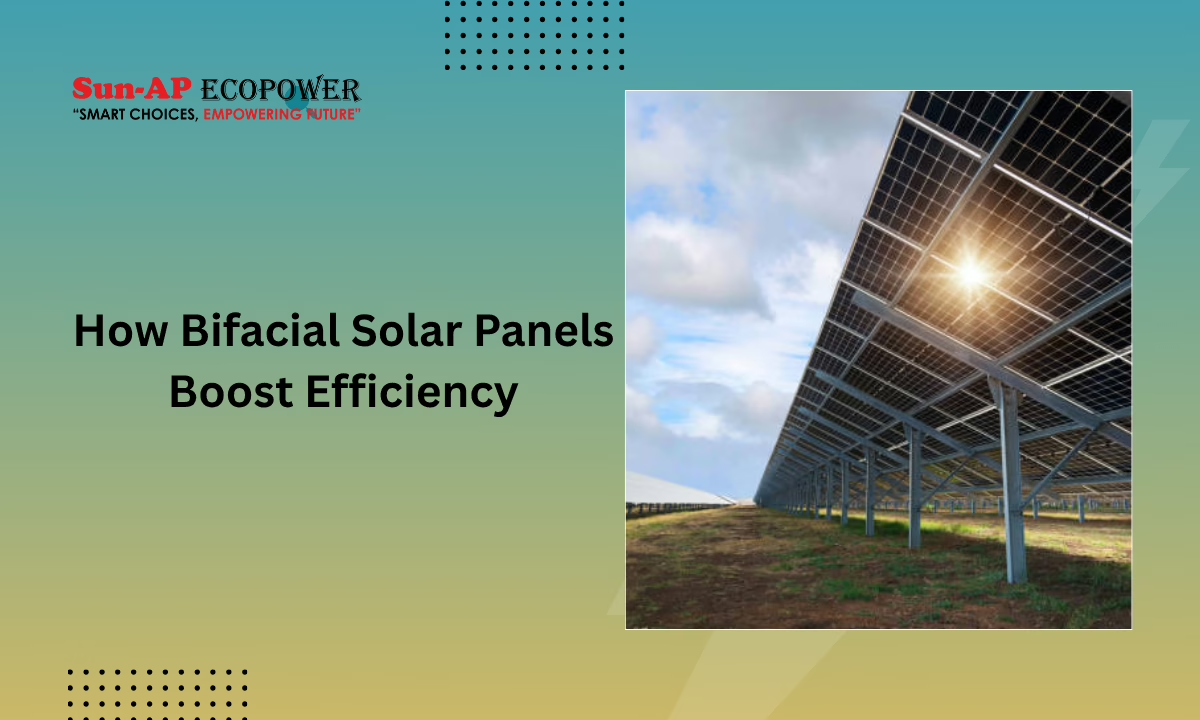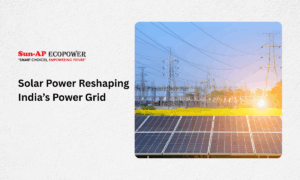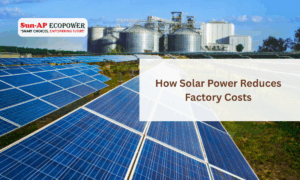When I walk around rooftops and solar farms, one of the innovations I’m most excited about is bifacial solar panels. These aren’t just your ordinary solar modules: they’re designed to capture sunlight on both their front and rear surfaces, setting a new benchmark in how we think about solar power.
In this post, I’ll explain how these panels work, why their efficiency is higher, what the technology involves, how size and installation matter, how they’re being adopted in India, and how we at Sun-Ap Ecopower help you tap into their full potential.
Bifacial Solar Panels

At their core, bifacial solar panels are modules that allow sunlight to hit both sides. Traditional (monofacial) panels capture light only on the front face. With bifacial designs, the back side of the module is transparent or uses a dual-glass design so that reflected light (from the roof, ground or other surfaces) is also harnessed. This extra capture of light leads to a measurable uplift in energy production. Installing them means more than just slapping a panel on a frame: we check reflectivity of surfaces beneath, tilt angles, shading, and mounting type, because all of those influence how well the “rear side” of the module performs.
Why Bifacial Solar Panel Efficiency is Higher
The big reason bifacial solar panels score higher efficiency is that they harvest light not just directly from the sun, but also reflected (albedo) light from behind. Real-world data shows modern modules can get front-side efficiencies in the 21–23% range, and the rear side contribution can add another 5–30% to total output depending on conditions.
In India, for example, bifacial modules are quoted with up to around 22% efficiency for mono-PERC half-cut cells and improved gains when the installation is optimized.
From our experience: when you combine a highly reflective rooftop surface (light colored paint or white covering), proper tilt, and minimal shading, the energy yield climbs noticeably, outperforming comparable monofacial modules. The increase in power generation means a faster return on investment — something our clients appreciate.
How Bifacial Solar Panel Technology Works
Let me walk you through the technology piece by piece — think of this as a behind-the-scenes look from the installation team.
- Dual-glass or transparent back sheets: Many bifacial modules use glass on the front and back (glass-glass) or a glass front with a transparent back sheet, enabling light to reach the rear side.
- High-efficiency solar cells (mono-PERC, TOPCon, n-type): These cells have improved passivation and better tolerance to degradation, which helps both front and rear operations.
- Albedo and rear-side illumination: The surface beneath the panel reflects light — snow, white concrete, water, even light-colored rooftops help the panel’s back side pick up additional photons.
- Optimized mounting/spacing: To avoid shading of the back side and maximize reflected light, mounting height, tilt, spacing between rows, and ground reflectivity matter. We plan these parameters carefully to get the most out of the panel’s rear side.
- Durability and structure: Because both sides are used, bifacial modules often come with enhanced frame/glass durability. For example, better moisture resistance, longer lifetime, and reduced performance loss.
In our projects, we often highlight to clients that while the upfront cost is a bit higher, the technology premium is justified by the higher energy per square metre and the long-term savings.
Size and Installations: Bifacial Solar Panel Size & Bifacial Solar Panels Rooftop
Size and installation context are important. Here’s how we approach it at Sun-Ap Ecopower:
- Panel size: Many bifacial panels now come in large formats (e.g., 156-cell half-cut modules), which offer higher wattage ratings. Capacity and size go hand in hand. For example, some modules in India measure about 2469 x 1133 mm for 610-650 W (front side) and more when bifacial gain is considered.
- Rooftop application: On rooftops, especially commercial or industrial ones, bifacial panels can perform very well. A rooftop with light-colored or reflective material beneath the modules, minimal obstructions, and good ventilation offers greater back-side gain. We always audit the rooftop surface: Is it white-painted, cement, metal sheet? How much reflectivity (albedo) does it have?
- Orientation and spacing: For rooftop installations, we try to avoid heavy shading, allow for some clearance beneath panels (if elevated), and use mounting structures that reflect light well beneath the modules.
- Limited space: If you don’t have a large space, bifacial panels help extract more power from a given area compared to monofacial panels. That makes them especially useful on rooftops where space is at a premium.
- In our experience, customers who invest in a properly designed rooftop bifacial system tend to see higher overall system performance per square metre, though they must be aware of installation nuances.
Market & Trends in India: Bifacial Solar Panels India & Dealers
The Indian solar market is increasingly embracing bifacial technology. According to industry reports, the Indian bifacial solar market is projected to grow at a CAGR of about 13.6% from FY2025 to FY2032. Here’s how I see things as someone on the ground:
- Growing awareness: More customers (residential, commercial, industrial) ask specifically for “bifacial modules” when we present proposals.
- Local supply & manufacturing: Indian manufacturers are ramping up glass-glass bifacial modules, dual-glass designs, and high-efficiency n-type/bifacial variants to serve local demand.
- Dealers & distribution network: Since bifacial modules are still newer than monofacial ones, it’s important to work with trusted solar panels & products dealers in India that can provide correct installation guidance and ensure the module is genuine. As a reliable Solar Panel Dealer in India, we supply, check module specifications, backsheet type, warranty terms, and installation best practices.
- Return on investment (ROI): Indian case studies report faster breakeven for bifacial installations (15-20% faster in some cases) compared to traditional panels.
- Policy environment: Indian government incentives, rooftop solar policies, net-metering frameworks, and declining module costs make it a favorable time to adopt newer technologies like bifacial panels.
If you’re looking for reputable solar panel dealers in India with bifacial capability, always ask for: module efficiency rating, rear-side gain estimate, warranty terms, considered installation surface (albedo), and actual expected energy yield.
Challenges to Consider
Since I’m proud of the technology but also honest with clients, I point out key factors to keep in mind:
- Installation surface matters: If the ground or rooftop beneath is dark, non-reflective, or heavily shaded, you won’t fully capture the rear-side benefit.
- Cost premium: Bifacial modules cost more upfront than comparable monofacial modules. The value comes with optimized installation and surface reflectivity.
- Maintenance and design care: Because you’re capturing light from both sides, things like debris, dirt, or shading on the rear side matter more.
- Size and tilt optimization: To exploit the rear side well, tilt, spacing, and row-to-row shading must be carefully designed, which means higher engineering input.
- Availability and supply chain: While improving, bifacial module availability and variety in India are not as massive as monofacial options. Some dealers may push them without proper site evaluation.
At Sun-Ap Ecopower, we evaluate all of these during our site survey so clients know what to expect in terms of yield and cost.
Why Choose Bifacial Panels
Based on the experience, we recommend bifacial solar panels when the site qualifies and the client aims for maximum energy output with a long-term mindset. Here’s why:
- They offer higher energy per square metre, helping rooftop owners maximize output when area is constrained.
- Longer lifetime and better durability in many cases, thanks to glass-glass designs and better cell technologies.
- Enhanced ROI when the installation is engineered correctly, reflecting our promise to clients of delivering performance and value.
- They future-proof the system better as module costs come down, and reflectivity/installation techniques improve over time.
When clients come to us and ask: “Will a bifacial system make sense for my rooftop in Chennai/Bangalore or industrial building in India?” we use our site-audit to decide, and often find that yes — if the roof surface is reflective, shading is minimal, and structural design allows good clearance — then the extra gain justifies the investment.
Final Thoughts
Working at Sun-Ap Ecopower, Solar Panel & Products Dealers In India, I’ve seen solar technology evolve rapidly. The advent of bifacial solar panels represents one of the most significant leaps in capturing more of the sun’s available power. The ability to harness light from both sides—front and rear—changes the game for rooftops, commercial installations, and large-scale solar farms alike.
By choosing the right installation surface, optimizing size and spacing, selecting high-efficiency modules, and working with trusted dealers, you unlock the full potential of bifacial technology. For Indian sites, where space, reflectivity, and cost all matter, bifacial panels can deliver higher yields, better ROI, and longer lifetimes than older monofacial options.
At Sun-Ap Ecopower, we promise to guide you through the complete journey—from site analysis through panel selection to installation and yield performance. If you’re evaluating a rooftop or large-scale project and want to understand how bifacial modules will perform in your specific environment, we’re here to help—from explanation to execution.
FAQs
Q1: What exactly does “bifacial gain” mean?
Bifacial gain is the percentage increase in energy output of a bifacial module compared to a comparable monofacial one under similar conditions. It reflects how much extra power comes from the rear side of the panel.
Q2: Can I use bifacial solar panels on any rooftop?
Yes, but the performance benefit will depend heavily on the rooftop surface reflectivity (albedo), clearance beneath the panels, shading and orientation. At Sun-Ap Ecopower, we assess these factors to ensure you’ll get meaningful gains.
Q3: Are bifacial panels much more expensive than conventional panels in India?
They do cost more upfront, but when properly installed, the extra energy yield and durability often lead to better long-term returns. Indian case studies suggest faster breakeven in many cases.
Q4: What size of bifacial panel should I consider?
Size depends on your energy needs, available rooftop or land area and mounting constraints. Many high-efficiency bifacial modules in India today come as large-format 610 W+ (front side) modules with enhanced rear-side output.
Q5: How do I pick a reliable solar panel & products dealer in India when going bifacial?
Look for a dealer who:
- Provides transparent module specifications (efficiency, rear-side gain, warranty)
- Does a site audit consider rooftop surface, tilt, shading and albedo
- Has experience in installing bifacial systems (not just monofacial)
- Offers monitoring and performance guarantees after installation.
At Sun-Ap Ecopower, we work with vetted dealers and handle end-to-end delivery for our clients.




